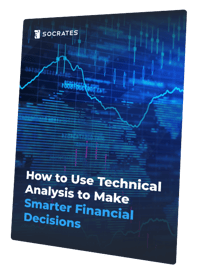Fundamental vs Technical Analysis:
Which Approach Is Best for Your Investing Strategy?



When investing in financial markets, the importance of researching and analyzing the market cannot be overstated. Any information you uncover acts as a compass, directing your decision-making and helping you identify clear pathways toward achieving your financial goals.
Investors who perform their own market research often rely on two approaches: technical and fundamental analysis. Both offer different ways of measuring an asset’s value.
Fundamental analysis involves examining a company's financial health, industry conditions, and economic factors to determine its value and long-term growth potential. On the other hand, technical analysis involves studying long-term cycles, trends, and patterns to identify price movements.
This raises an obvious question: which form of analysis is better? The answer is that neither technical or fundamental analysis offers an intrinsically better approach. Both have their uses and, when deployed correctly, can be used to improve financial decision-making. We explore both approaches in greater detail below, providing insights to help you understand which form of analysis is more relevant to your investing strategy.
What Is Fundamental Analysis?
The core belief guiding fundamental analysis is that an asset’s true value can be determined by studying the underlying economic, financial, qualitative, and quantitative factors that impact an asset.
When researching a stock, for instance, the fundamental approach requires studying financial statements, including profit and loss accounts, balance sheets, and cash flow statements. It also looks at external influences such as the state of the economy and industry conditions. Internal factors such as the company’s business model and the effectiveness of its management are also important. By performing this deep dive, you should develop a keen sense of whether the stock is undervalued, overvalued, or rightly valued, providing a basis for investment decisions.
This method is well-suited to stock analysis because it helps investors determine the intrinsic value of a company and predict its financial health. Contrary to popular belief, the principles and techniques of fundamental analysis can also be applied to other types of investments, including commodities, bonds, and currencies. For each of these investment types, the focus and specifics of the analysis may vary:
- Commodities: When applied to commodities, fundamental analysis looks at supply and demand factors that can influence prices. For instance, analysts may study geopolitical events, production data, and economic indicators that affect commodity markets like oil, gold, or agricultural products.
- Bonds: Analysts may assess the creditworthiness of the issuer, economic conditions that influence interest rates, and other factors like the maturity of bonds and the likelihood of repayment.
- Currencies: For currencies, analysis revolves around macroeconomic indicators, central bank policies, political stability, and the economic performance of a country. Factors such as GDP growth rates, employment levels, inflation, trade balances, and interest rate policies are crucial in assessing the strength or weakness of a currency.

Results
By using the Timing Arrays to research the market’s cyclical activity, we were able to identify the week of July 17th as a potential turning point — and a few days within that week where cyclical activity seemed to be most notable.
After this analysis, we turned our attention to studying the price action of the underlying market.

Is Fundamental Analysis Right for You?
Fundamental analysis might be the right choice for you if you have a long-term investment horizon and prefer to base your decisions on a thorough understanding of an asset’s intrinsic value. It requires patience and a commitment to ongoing research, as you'll need to continually assess economic conditions, market trends, and asset performance over time. Reversals). When this clustering of Reversals occurs, more energy (momentum) will be needed to break through.
Advantages of fundamental analysis
- Long-term Perspective: Fundamental analysis focuses on long-term investment opportunities by assessing an asset’s sustainability and growth potential over several years.
- Comprehensive Understanding of Investment Value: Helps investors make informed decisions based on an extensive evaluation of financial health and economic indicators.
- Includes Qualitative Factors: Considers impactful factors like management quality, brand value, and market reputation.
Disadvantages to fundamental analysis
- Fundamental Analysis Is Time-Consuming: Analysis requires a considerable amount of time and effort to gather, analyze, and interpret a vast array of financial statements, and qualitative and quantitative data.
- Doesn’t Account for Market Psychology: External factors such as investor sentiment and market irrationality aren’t captured by fundamental indicators.
- Analysis Can Be Subjective: Qualitative factors can lead to subjective analysis and conclusions that differ from one analyst to another.
What Is Technical Analysis?
Technical analysis doesn’t attempt to measure an asset’s intrinsic value. Instead, the approach uses charts and other tools to determine whether current activity is a trend. And if so, if that trend is likely to continue or reverse. Technical analysis is based on the belief that financial markets operate as a cycle and that long-term historical data is key to understanding current and future market activity.

Technical analysis is also based on the assumption that all known information is already reflected in prices, freeing you up to focus on price movements rather than the fundamental health of an asset. Technical analysts rely on:
- Access to Historical and Current Market Data: Comprehensive historical data enables analysts to study long-term trends and short-term movements to forecast future prices accurately. At the same time, current data helps analysts make immediate decisions based on the latest market movements. This is especially important for day traders and those using very short-term trading strategies.
- Technical Indicators: These are mathematical calculations based on the price, volume, or open interest of an asset. Common technical indicators include the Relative Strength Index (RSI), moving averages, and stochastic oscillators. Each indicator serves a different purpose, such as identifying momentum, trends, or volatility, and is used to support buying or selling decisions.
- Market Charts: Charts visually represent market data over a period, making it easier to observe trends, patterns, and potential reversals. Types of charts include line charts, bar charts, and candlestick charts, each offering different insights. Candlestick charts, for instance, show the open, high, low, and close prices within a specific timeframe.
Is Technical Analysis Right for You?
Many investors rely on technical analysis to swiftly respond to market movements and identify short to medium-term investment opportunities. By utilizing current data and employing tools like chart patterns and technical indicators, analysts can pinpoint precise moments to enter or exit trades. Historical cycles and broad market trends are also key to recognizing long-term investing opportunities.
Advantages of technical analysis
- Quick Decision-Making: Allows investors to react rapidly to market fluctuations based on the price and volume data.
- Psychological Insights: Charts can reflect the psychological state of the market, providing insight into whether traders are likely to buy or sell based on market sentiment.
- Simplicity: Unlike fundamental analysis, which requires a deep dive into financial data, technical analysis often uses graphical representations that are visually straightforward and easier to interpret.
Disadvantages of technical analysis
- Self-Fulfilling Prophecy: Indicators may influence investors to make similar decisions. This collective action skews the market.
- Overlooking Fundamentals: The technical approach focuses on price action, ignoring critical fundamentals that affect an asset.
- Market Noise: Short-term market fluctuations can generate misleading signals, which can lead to false trading decisions if not interpreted carefully.
For more insights on performing your own technical analysis, read our guide to using technical analysis to make smarter financial decisions.
Technical Analysis vs. Fundamental Analysis
Fundamental Analysis |
Technical Analysis |
|
|
Focus |
Evaluates assets by analyzing financial and economic factors. |
Analyzes market patterns, trends, and cycles to identify price movements. |
|
Objective |
Determine intrinsic value and long-term potential. |
Capitalize on market trends and patterns. |
|
Primary Focus |
Financial health, company value, and economic conditions. |
Price patterns, volume, and historical market data. |
|
Data Used |
Financial statements, economic reports, industry analysis. |
Price charts, volume, and indicators. |
|
Strengths |
Deep insight into asset value, reduced market noise impact. |
Precise decision-making, effective in volatile markets. |
|
Limitations |
Time-consuming, requires extensive knowledge. |
Can ignore fundamental business value, may generate false signals. |
|
Market Sensitivity |
Less sensitive to short-term market fluctuations. |
Highly sensitive to immediate market movements. |
The Best of Both Worlds: Combining Both Fundamental and Technical Analysis

Integrating fundamental and technical analysis offers investors a more holistic approach to navigating the financial markets. This combination enhances decision-making by marrying the in-depth evaluation of an asset from fundamental analysis with the precise market timing insights offered by technical analysis. An integrated approach facilitates optimal entry and exit points for investments while also reducing risk by ensuring investments are both technically and fundamentally sound.
Of course, no methodology or approach to financial market analysis is a silver bullet that eliminates risk. Investors must conduct their research and make decisions with this in mind.
How Socrates Can Enhance Technical Analysis

The Socrates Platform is a market research platform offering access to advanced proprietary computer models that apply technical analysis methodologies. Our market research tools provide a robust framework for identifying market trends and investing opportunities. These models generate detailed, computer-analyzed text that simplifies the interpretation of complex data, highlighting key signals, patterns, and trends.
Designed to provide a global view of financial markets, the Socrates Platform's proprietary models have been meticulously developed over several decades. They capture long-term historical data on over 1000 key markets and provide unbiased insights crucial for informed decision-making.
See Socrates in action by reading how our unique toolset was used to uncover opportunities in British Pound Futures and identify a downturn in Japanese Yen Futures.
Want to learn how Socrates can support your technical analysis and market research?
Access our Guide
To learn more about using market data to your advantage, access our guide, How to Use Technical Analysis to Make Smarter Financial Decisions.
